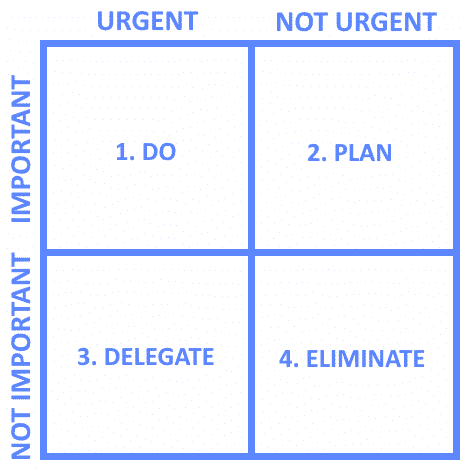We all have a lot of tasks to do, and it can sometimes be difficult to figure out which of them have a higher priority than others.
To solve this problem, you can try evaluating each of the tasks using The Urgent-Important Matrix, also known as The Eisenhower Matrix. This method is based on the US President Dwight D. Eisenhower’s quote.
What is important is seldom urgent and what is urgent is seldom important.
– Dwight D. Eisenhower
Urgent-Important Matrix
Urgent-Important Matrix is a powerful tool that can drastically improve your productivity. It consists of 4 quadrants that will classify your tasks that need to be done according to their urgency and importance.

1. Do – Urgent and Important
In this quadrant put pressing issues that are both urgent and important, so there can be serious consequences if you ignore them. An example would be a family member in a hospital or paying your bills at the end of the month. You should take care of these issues as soon as possible.
2. Plan – Not Urgent and Important
In the second quadrant are tasks that are important, and not urgent, for example, working out, maintaining good relationships with friends, learning new skills etc. You need to schedule time for these activities and stick to the schedule.
3. Delegate – Urgent and Not Important
In this quadrant are urgent activities that are not related to your top priorities, e.g. questions or requests from colleagues, incoming calls. Whenever possible, reject and avoid these tasks, since they take away time from the first two quadrants. You can also delegate these tasks to others if that’s an option.
4. Eliminate – Not Urgent and Not Important
Here you can place tasks and activities that are neither urgent nor important and are wasting your time, for example, watching TV, scrolling through social media etc. You should eliminate these tasks whenever possible and plan to avoid them, so you can spend your time on more important tasks.
Evaluate yourself
To improve your productivity, it’s important to take a look at where you are right now. This will make it easier for you to understand your time distribution between the four quadrants, and plan the activities for the future.
To evaluate yourself, imagine your normal week and estimate how many percents of your time you spend on each quadrant. An example would be:
- 1st quadrant: 10%
- 2nd quadrant: 40%
- 3rd quadrant: 20%
- 4th quadrant: 30%
If you find it difficult to come up with these percentages, you can write down everything you are doing and how much time it takes. At the end of the week, sort the activities to the quadrants and calculate how much time each quadrant makes up.

It’s important to spend as much time as possible doing the activities in the second quadrant. The most productive people spend around 80% of their time doing these tasks. If you increase the amount of time you spend on these activities, you will make significant steps towards your goals, learn new skills and have a calmer life in general.
What are some productivity tips you like using? Leave them in the comment section below! 🙂
